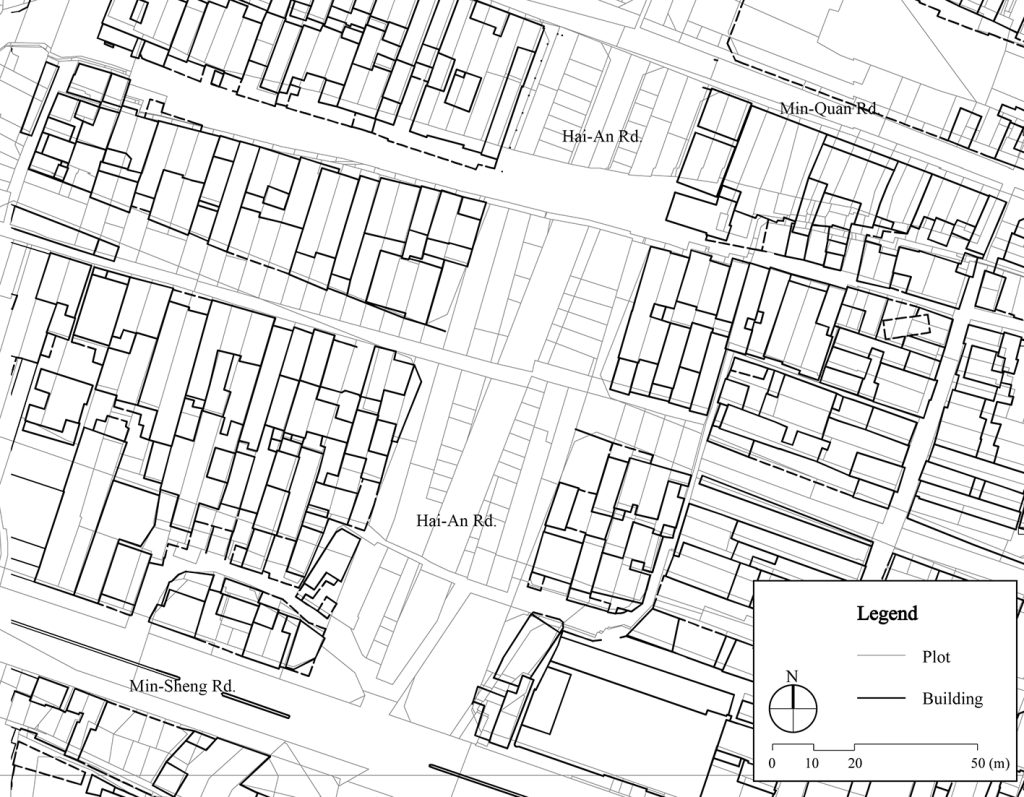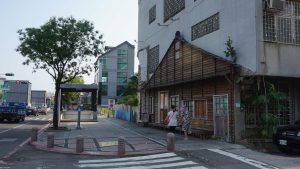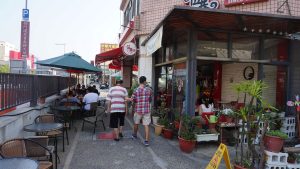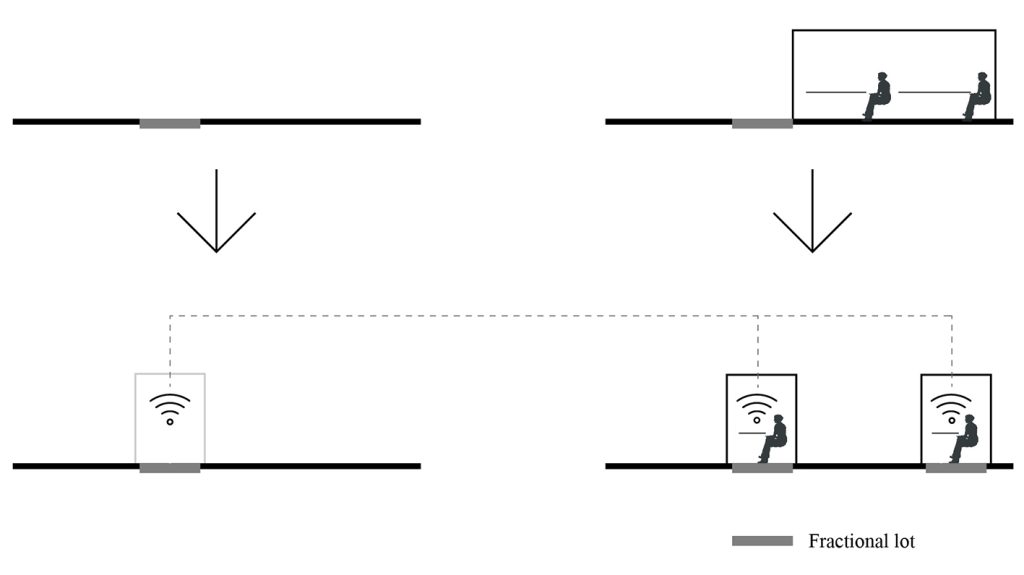65
Chih-Hung Chen and Lin-Fang Hsu, National Cheng Kung University, Taiwan
What are redundant spaces?
In manufacturing, there are numerous redundant materials left over after the production process and these piecemeal leftovers are usually regarded as waste and are thus disposed. As for urban planning, land can be likened to the raw materials in a manufacturing-like process, and urban planners are acknowledged as the most powerful place designers. After an urban plan is delivered, land is divided into different units, containing various activities; in addition the plots of the plan area will be redivided (Conzen & Conzen, 2004). The organic urban pattern may be substituted by the regularly arranged urban plan. Consequently, many plot fractions are generated, being adjacent to the so-called rationally arranged places (Fig. 1.) (Chen, Hsu & Li, 2013). These fractions are commonly known as fractional lots, usually unused and literally redundant.

Rethinking the value of redundant spaces
In recent years, people have noticed the importance of environmental protection, and have thus began to pay attention to the issue of waste disposal. With a view to managing waste, the revised Waste Framework Directive (2008/98/EC) established the European Waste Hierarchy, consisting of five levels: disposal, recovery, recycle, reuse, and prevention (European Parliament & Council of the European Union, 2008). Land, an indispensable resources, should not be wasted. Nonetheless, this framework is applicable for most redundant materials but difficult for redundant spaces to follow because of their fixedness. The fractional lots, scattered on a street, cannot be gathered and merged into one complete unit for a certain function. Therefore, the management of redundant spaces is distinct from other resources.
There are two approaches to achieving waste reduction, 1) putting fractional lots to good use (Baum, 2012) and 2) eliminating fractional lots, both of which can be supported by the use of Information and Communication Technologies (ICTs).

Revitalising redundant spaces with ICT
Information and Communications Technologies (ICT) can help to facilitate the reuse and the recycling of ‘lost spaces’ (Trancik, 1986). Abandoned spaces can be turned into energetic places simply by the installations of the ICT facilities, for example public spaces with Universal Serial Bus (USB) Dead Drops are attractive to the public. Furthermore, recycled fractional lots can be used to accommodate temporary constructions such as interactive installation art (Fig. 2.) and pop-up shops or shophouses (see Fig. 3 below). These places are transformed into Wi-Fi hotspots providing services for people with mobile devices. Such solutions, based on knowledge dynamics, can revitalise lost spaces with relatively low cost (Chen & Lin, 2014). In contrast, there is a more active way to tackle land waste in urban plans. The recombination of plots can radically recover the use of redundant spaces. Fractional lots can be merged with their adjacent lands by planning. The recovery process concerns the redivision of property and thus is time consuming and costly. On the other hand, planners must consider the urban fabric and the division of plots in the planning process for the prevention of generating further fractional lots. Such morphological analyses should be considered critical in urban planning schemes, such as when the economic value of fractional lots is included in the financial plan of a project, redundant spaces are not created so easily (Rydin, 2011).

The digital evolution of everyday lives
The reuse and recycling of fractional lots can be delivered swiftly with the help of ICT, which is transforming the way people live and work. In comparison to the past, people in the contemporary world can put their files in the cloud, which can help to save physical spaces for storage, and besides people in different locations can communicate with each other through telephones or web cameras. Therefore, massive building blocks are divided into smaller pieces to contain the activities for a new era. Separately redundant spaces, each of which may be isolated, can be functionally connected by ICT (Fig. 4.) (Frey, 2009), connecting knowledge and social dynamics (Oldenburg, 1999) in intangible ways (Alexander, Ishikawa & Silverstein, 1977; Böhme, 2006; Oswalt, Overmeyer & Misselwitz, 2013). As a result, the agglomeration of digital activities can help to achieve the cluster effect, which is a great contribution to knowledge capital (Delgado, Porter & Stern, 2010).

East Asia experiences
In the context above, after the World War II, the economy of most countries in East Asia, such as Taiwan, Korea and Singapore, galloped ahead which resulted in a population explosion and dramatic transformations of infrastructures. Population growth brought about massive residential needs and thus numerous urban plans had been delivered rapidly with relatively low precision. Without considering local spatial context, those urban plans fragmented the original urban form and consequently fractional lots had been created. Furthermore, the transformation of industry led to the acceleration of urbanisation. Land scarcity became a critical issue and resulted in the development of suburban areas (Sieverts, 2005; Whitehand & Carr, 2001) which may damage the nature environment and increase energy consumption. Based on the above, two approached identified by this paper are solutions to reduce the impact from the ineffectiveness of current planning system and achieve sustainability. In many East Asia cities, various pop-up restaurants are installed on fractional lots, which can be a remedy for inaccuracy in urban planning. The heterogeneous forms of these places can incubate diverse activities and thus enhance the competitiveness of cities (Jacobs, 1969).
Achieving sustainability through knowledge
Sustainability or, more specifically, the self-balancing of the environment could be broken as natural resources are overused which, in urban areas, may be caused by inefficient land management. Based on the concept, “knowledge cities”, ICT may be the key components to improve the efficiency of urban land use, and further turn these spaces into essential places for social connection. The introduction of ICTs in urban planning can help planners to explore more possibilities of each urban land unit. In light of the incompatibilities between urban development and the natural environment, knowledge dynamics may be the answer to break the current impasse in sustainable development.
Acknowledgement
The work described in this paper is partially supported by the Ministry of Science and Technology (Project No. MOST 104-2621-M-006-012 -) of Taiwan.
References
Alexander, C., Ishikawa, S. & Silverstein, M. (1977). A pattern language. New York, Oxford University Press.
Böhme, G. (2006). Architektur und Atmosphäre. München, Wilhelm Fink.
Chen, C., Hsu, L. & Li, Y. (2013). Spaces of fractional lots as potential places for knowledge production. In: Knowledge cities World Summit. [Online]. 2013 Istanbul, Lookus Scientific. pp. 633-641. Available from: http://eprints.qut.edu.au/62599/1/KCWS_2013_PROCEEDINGS.pdf [Accessed: 12 May 2015].
Chen, C. & Lin, W. (2014). Arcade in the old Centre as an Instrument of the creative Milieu on Aspect of Knowledge Processes. In Carlucci, D., Spender, JC & Schiuma, G. (Ed.), Knowledge and Management Models for Sustainable Growth. 9th International Forum on Knowledge Asset Dynamics (IFKAD-2014). pp. 2276-2291. Matera, Italy.
Conzen, M.R.G. & Conzen, M. (2004). Thinking about urban form. Oxford, Peter Lang.
Delgado, M., Porter, M. & Stern, S. (2010). Clusters and Entrepreneurship. SSRN Journal. [Online] Available from: doi:10.2139/ssrn.1689084.
European Parliament & Council of the European Union (2008). Directive 2008/98/EC of the European Parliament and of the Council of 19 November 2008 on waste and repealing certain Directives. [Online]. p.10. Available from: http://eur-lex.europa.eu/legal-content/EN/TXT/PDF/?uri=CELEX:32008L0098&from=EN [Accessed: 12 May 2015].
Frey, O. (2009). Die amalgame Stadt. Wiesbaden, VS, Verlag für Sozialwissenschaften.
Jacobs, J. (1969). The economy of cities. New York, Random House.
Oldenburg, R. (1999). The great good place. New York, Marlowe.
Oswalt, P., Overmeyer, K. & Misselwitz, P. (2013). Urban catalyst. Berlin, Dom Pub.
Rydin, Y. (2011). The purpose of planning. Bristol, Policy Press.
Sieverts, T. (2005). Zwischenstadt – inzwischen Stadt?. Wuppertal, Müller und Busmann.
Sitte, C. (1909). Der Städtebau nach seinen künstlerischen Grundsätzen. Braunschweig [u.a.], Vieweg.
Trancik, R. (1986). Finding lost space. New York, Van Nostrand Reinhold.
Whitehand, J. & Carr, C. (2001). Twentieth-century suburbs. New York, Routledge.
Baum, M. (2012). Future Viability Requires Adaptability and Stability Dynamic, Stable Structures in the Context of Sustainable Urban Development In Ziehl, M., Oßwald, S., Hasemann, O & Schnier, D. (Ed.), Second hand spaces. (pp. 304-308) JOVIS Verlag.
Author Biographies
Chih-Hung Chen is an Assistant Professor of Department of Urban Planning at the National Cheng Kung University in Taiwan and a registered architect at AKS in Germany. He is a commissioner of the Committee of Urban Design and Land Use Development Permit & Review, Kaohsiung. He specialises in urban morphology and modern urban history. His research covers a wide range of topics, which mainly concern urban design. He has focused on the logic of urban form, related to social behaviour, and related tools of spatial analysis, applicable to urban planning. Based on his findings, using urban spaces efficiently may be a radical approach to achieving urban sustainability.
Contact email: chihhungchen@mail.ncku.edu.tw
 Lin-Fang Hsu is a Research Assistant for the Douliu Sugar Refinery Cultural Landscape Preservation Master Plan led by Prof. Chih-Hung Chen at the Department of Urban Planning, National Cheng Kung University in Taiwan. She has a Master’s degree in Urban Regeneration from the Bartlett School of Planning, University College London (UCL). She is interested in the topics of urban regeneration and the revitalisation of historical quarters.
Lin-Fang Hsu is a Research Assistant for the Douliu Sugar Refinery Cultural Landscape Preservation Master Plan led by Prof. Chih-Hung Chen at the Department of Urban Planning, National Cheng Kung University in Taiwan. She has a Master’s degree in Urban Regeneration from the Bartlett School of Planning, University College London (UCL). She is interested in the topics of urban regeneration and the revitalisation of historical quarters.

